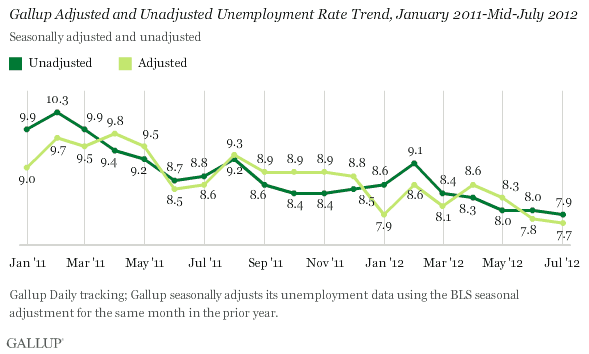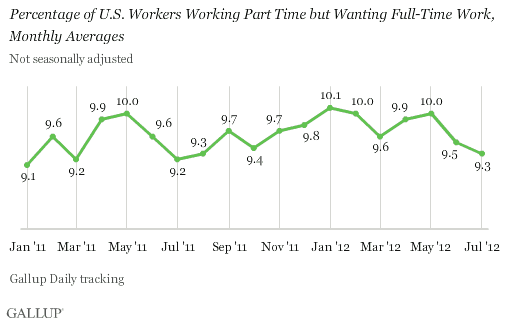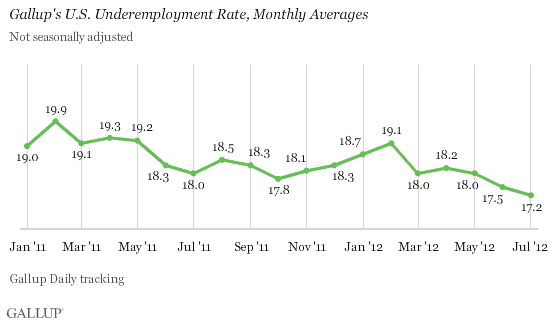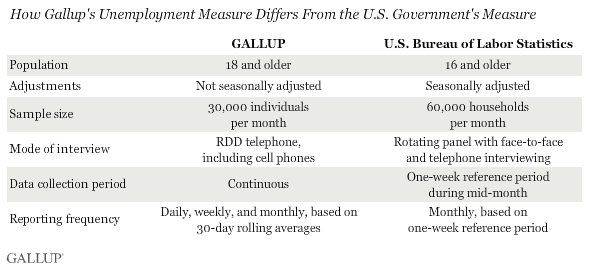PRINCETON, NJ -- U.S. unemployment, as measured by Gallup without seasonal adjustment, was 7.9% in mid-July, down 0.1 percentage points from June and May. Gallup's seasonally adjusted unemployment rate also declined 0.1 points, to 7.7% in mid-July.

These results are based on Gallup Daily tracking surveys conducted from June 15 to July 15, including interviews with more than 30,000 U.S. adults -- 68.0% of whom are active in the workforce. Gallup's seasonally adjusted unemployment rate incorporates the adjustment used by the U.S. Bureau of Labor Statistics in the same month of the previous year.
On both an unadjusted and an adjusted basis, the mid-July unemployment readings, if sustained the rest of the month, would be the lowest monthly rates since Gallup began tracking unemployment daily in January 2010. Gallup's adjusted unemployment rate incorporates the downward seasonal adjustment of 0.2 points the BLS applied in July 2011. Gallup's unadjusted unemployment rate for July 2011 was 8.8% and the adjusted rate was 8.6% -- both substantially higher than they are now.
The Percentage Working Part Time but Wanting a Full-Time Job Down From June
The percentage of Americans working part time but looking for full-time work was 9.3% in mid-July, on an unadjusted basis, down slightly from the 9.5% in June, but up slightly from 9.2% a year ago.

Underemployment Down From a Year Ago, at Lowest Level Since 2010
Gallup's U.S. underemployment measure, which combines the unemployed with those working part time but looking for full-time work, is 17.2% in mid-July, down from 17.5% in June. The underemployment rate is also down from 18.0% last July and ties its lowest monthly level since January 2010, when Gallup Daily tracking of the metric began.

Implications
Both the U.S. government's unadjusted unemployment rate of 8.4% in June and its adjusted rate of 8.2% are substantially higher than Gallup's June readings. As a result, it is possible that the government will report a decline in the unemployment rate for July because its measurements, which are based on a one-week reference period in the middle of the month, catch up with Gallup's, which track unemployment continuously throughout each month. Additionally, if the recent sharp decline in the government's jobless claims to 350,000 continues, there is a greater likelihood that the government will report a lower unemployment rate for July.
On the other hand, BLS payroll survey results have shown modest increases, averaging about 75,000 new jobs monthly during the second quarter. But these slight increases are generally not enough to lower the unemployment rate. Further, the early July decline in Gallup's economic confidence measure, as well as the sharp drop in June retail sales, provides little reason for optimism about reducing unemployment in the months ahead.
Regardless, even with the mid-July decline of 0.1 points, Gallup's unemployment data show little improvement during the past three months -- not good news for those looking for a job, the nation's retailers, or the future course of the U.S. economy.

Gallup.com reports results from these indexes in daily, weekly, and monthly averages and in Gallup.com stories. Complete trend data are always available to view and export in the following charts:
Daily: Employment, Economic Confidence, Job Creation, Consumer Spending
Weekly: Employment, Economic Confidence, Job Creation, Consumer Spending
Read more about Gallup's economic measures.
View our economic release schedule.
Survey Methods
Results are based on telephone interviews conducted as part of Gallup Daily tracking from June 15-July 15, 2012, with a random sample of more than 30,000 adults, aged 18 and older, living in all 50 U.S. states and the District of Columbia, selected using random-digit-dial sampling.
For results based on the total sample of national adults, one can say with 95% confidence that the maximum margin of sampling error is ±1 percentage point.
Interviews are conducted with respondents on landline telephones and cellular phones, with interviews conducted in Spanish for respondents who are primarily Spanish-speaking. Each sample includes a minimum quota of 400 cell phone respondents and 600 landline respondents per 1,000 national adults, with additional minimum quotas among landline respondents by region. Landline telephone numbers are chosen at random among listed telephone numbers. Cell phone numbers are selected using random-digit-dial methods. Landline respondents are chosen at random within each household on the basis of which member had the most recent birthday.
Samples are weighted by gender, age, race, Hispanic ethnicity, education, region, adults in the household, and phone status (cell phone only/landline only/both, cell phone mostly, and having an unlisted landline number). Demographic weighting targets are based on the March 2011 Current Population Survey figures for the aged 18 and older non-institutionalized population living in U.S. telephone households. All reported margins of sampling error include the computed design effects for weighting and sample design.
In addition to sampling error, question wording and practical difficulties in conducting surveys can introduce error or bias into the findings of public opinion polls.
For more details on Gallup's polling methodology, visit www.gallup.com.
